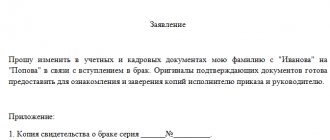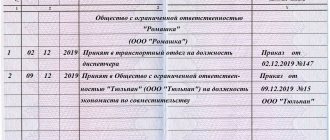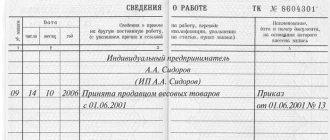Mistakes are made not only by amateurs, but also by professionals in their field.
Due to inattention, haste or other reasons, even experienced employees of personnel services of organizations and enterprises, when filling out work books, can write one word incorrectly, screw up an entire entry or miss the numbering.
No one is immune from this. It happens that documents arrive with existing errors that were made by previous employers .
In small companies, a similar situation is observed even more often , because in most cases they do not have a personnel department, and another specialist, for example, secretary .
Every working person is recommended to carefully monitor the filling out of his book and, if he discovers an incorrect entry, immediately inform his boss or personnel officer about it.
Common mistakes
Typically, erroneous information appears for objective reasons (change of surname due to marriage, reinstatement of an employee by court decision) or due to the inattention of the specialist who fills out the document. Most often you can notice:
- incorrect indication of the worker’s first, patronymic and last name on the title page;
- incorrect dates of hiring, transfer to a new position, dismissal;
- inaccurate job title;
- missing letters, grammatical errors.
Since even one wrong character can cause a dispute when an employee goes to apply for a pension, personnel officers must be extremely careful. You should always check with the employee’s other documents - passport, birth certificate, marriage certificate, education diploma. And if an inaccuracy does creep in, it must be corrected correctly.
Errors in filling out the insert
If an employee often changes jobs, then there may not be enough sections in the work report. To continue recording, a special insert is purchased. If the personnel officer is inexperienced, he may have difficulty making corrections to the insert.
To correct errors, it has a number of rules:
- If the personnel officer made a mistake when making the first entry, the entire sheet is destroyed. An act is drawn up, signed by the employee and the personnel officer.
- If you filled out several columns by mistake, make corrections by analogy with other sheets.
- Confirm new entries with orders that coincide in numbering with the corrected entries.
Changes and corrections in labor: how to do it correctly
In accordance with Section III of Government Decree No. 225, the employer may correct:
- surname, first name, patronymic;
- date of birth;
- information about education;
- name of the employee’s profession or specialty;
- information about awards.
The main rule of the personnel officer when correcting erroneously entered information is no crossing out. This is only permissible when correcting incorrect information on the title page. In other cases, changes are made by recognizing certain entries as inaccurate and making correct ones. In this case, the new data must be certified by the signature of the responsible person and, if available, the seal of the organization or personnel service.
Clause 1.2 of Resolution of the Ministry of Labor of Russia No. 69 specifies exactly how amendments should be made. Here is an example algorithm:
- Indicate the serial number.
- Enter the current date (day, month, year).
- In the next column, write down exactly what information is not true and what it should be replaced with.
- In the last column, indicate the details of the order or document on the basis of which the correction is made.
Please note: this algorithm is relevant for correcting information not only about labor documents, but also about inserts for them.
Sample correction in the work book 2020
We change, supplement and correct entries in the work book
class=”
- If an error is discovered while making entries by second or subsequent employers, as well as by the employee himself, after making entries in the “Work Information” column, it will no longer be possible to correct this inaccuracy using the method described above.
- incorrect information is crossed out with one line and the correct data is entered,
- and on the inside cover of the work book an entry is made with reference to the document that served as the basis for the changes,
- the entry made in this way is certified by the signature of an authorized person and the seal,
- sometimes such an entry is also accompanied by writing something like the following: “corrected Natalia to Natalia believe.”
An employee who is faced with such a nuisance can be recommended to go to court to have this work book recognized as belonging to him
. This recommendation is based on a comparison of the norms of two fundamental regulatory legal acts on confirmation of length of service: clause 44 of the Decree of the Government of the Russian Federation of July 24, 2002 No. 555 “On approval of the Rules for calculating and confirming insurance experience for establishing labor pensions” and clause 26 of the Rules for calculating and confirming insurance coverage length of service to determine the amount of benefits for temporary disability, pregnancy and childbirth, approved by order of the Ministry of Health and Social Development of Russia dated 02/06/2007 No. 91. They provide that if the name, patronymic or surname of a citizen in the document on insurance experience does not coincide with his name, patronymic or surname indicated in the passport or birth certificate, the fact that this document belongs to this citizen is established on the basis of a marriage certificate, a certificate of change of name, certificates from competent authorities (officials) of foreign states or in court - depending on what data and due to some circumstances they do not coincide.
To be fair, it should be noted that in practice there is another point of view on this issue: corrections can be made in the usual manner at the place of work where the corresponding incorrect entry was made, or by the employer at a new place of work on the basis of an official document of the employer who made such an error. Experts who hold this opinion usually refer to clause 27 of the Rules, which describes the general rules of action in the event of an incorrect or inaccurate entry in the work book, as well as to clause 30 of the Rules, which indicates that crossing out is not allowed only in sections of the work book containing information about work or information about awards. Based on these standards, and also using by analogy clause 2.3 of the Instructions, they carry out the following actions:
In this regard, I would like to note that any deviation from the established instructions on making corrections to entries contained in work books carries the risk of liability for failure to comply with the procedure for maintaining work books, therefore the proposed option of correcting records with reference only to the general rules for such corrections seems controversial.
The following circumstance is also important. How can an employer determine that the work book belongs to the person who presented the passport? After all, the similarities of other data about the first name, patronymic and last name, year of birth do not indicate anything. Making corrections to the entries on the title page means acting at your own peril and risk. In addition, as already noted, even the competent authorities, when determining the insurance period, do not take the risk of recognizing the work book as belonging to the person who applied to them only on the basis of a passport. Moreover, the employer cannot do this. The only correct approach in such a situation seems to be, we repeat, the employee’s own appeal to the judicial authorities in order to properly establish the fact that the work book belongs to him.
Making corrections to entries previously made by another company
Option 1. Correct for another organization
Based on the relevant documents, the employer who discovered or made an inaccuracy himself can correct any section in the work book. An employee is not required to go to the company where he previously worked to correct incorrect data. Moreover, sometimes this is simply impossible. At the request of the worker, changes are made by the responsible person of the organization where he is currently employed.
What documents can confirm the correction of erroneous information? It all depends on the situation. This could be a certificate from the archive, a court decision, or a copy of the document confirming the basis for correcting the data, confirmed by the previous employer. Witness testimony in this case has no legal force.
Option 2. The employee turns to the previous employer for correction.
If a person finds incorrect information in the Labor Code, he can contact his previous employer with a request to correct it. If he is already employed, then he writes an application with a request to give him a work book in order to make corrections to it. Then he brings the document to the human resources department of his previous employer, where he must correct the inaccuracies.
If a person does not have a new job, after the lines with information about dismissal, the former employer writes which entry is considered invalid.
If the ex-employee has already found a job, and new entries have appeared in his employment record, the former employer follows the following algorithm:
- Writes the name of the company.
- Indicates the next entry sequence number and date.
- In column 3, he clarifies which information is incorrect and enters the correct information.
- In the last column enters the details of the base document.
Corrections for wrongful dismissal
An employee who was dismissed under a “bad” article of the Labor Code and reinstated in his position by a court decision has the right to insist on getting rid of the discrediting entry in his work book. In such circumstances, the employer, based on the employee’s personal written application, is obliged to issue him a duplicate work book at his own expense.
Remember: a duplicate work book in case of illegal dismissal is issued at the employee’s last place of work. If an employee, after being fired “under an article”, got another job, and filed a lawsuit against the previous employer for reinstatement, then a duplicate should be issued at the new place of work.
Several errors at once
If there are several inaccuracies, each one must be corrected. If they are contained in dates, job titles, information about orders, then the personnel officer makes entries recognizing each of the incorrect formulations as invalid. Then indicates the correct data. It is also possible to correct several incorrect ones with one entry.
Sample correction of an entry in the work book 2021, if you need to cancel the last two marks
Who makes corrections and for what reasons?
Only persons authorized by the employer are allowed to enter information or correct it if errors or inaccuracies have been made. Typically these are HR department employees or one HR specialist. He can detect incorrect information on his own or with the help of colleagues, including the owner of the document.
Typically, an employee of the organization where the errors were made should correct an erroneous entry in the work book. But if a person has changed his place of work, then, based on the documents, new data is entered by a representative of the employer for whom the person currently works. Confirmation papers are requested from the previous employer or in the archive.
Corrections on the title page
All incorrect information on the title page is simply crossed out. The exact version, certified by signature and seal, is indicated next to it. This applies to cases where an employee has changed personal data, as well as situations where an error was made due to the inattention of the person who filled out the document.
It is recommended that the correction of the full name. employee on the title page was made by the employer who created the work book. Because only he can know exactly in whose name he issued this document. To avoid problems with assigning someone else’s labor code, the employee should be sent to the very first employer. If the company is liquidated or refuses to correct inaccuracies, the employee can go to court and demand that this work book belong to him.
If you need to indicate a new specialty or additional education on the title page, you do not need to cross out anything. In this case, put a comma in the required line and write new data.
How to correct the name?
How to change the name in the work book? If you decide to change your name, you can probably be called a brave person. Just think, you can decide to take such a global step only if you have a strong desire, or objective reasons.
One way or another, the name change should not go unnoticed for your work record. In order to make changes to this document, you must have with you a certificate of name change, as well as, if possible, a new passport .
You must provide these documents to the HR department employee to correctly correct the name in the work book. The employee, in turn, must remove the work book from his personal file and begin making changes.
Your name in the work book is crossed out with a straight line. The new one fits on top. On the opposite side of the spread, the employee writes the following phrase: The name such and such has been changed to such and such in accordance with certificate number such and such.
All records are made as accurately and clearly as possible so that another employer can read them in the future.
Errors in award information
For most employees, this section is empty, since this place contains information about awarded diplomas, certificates, titles, and other awards. Therefore, awards pages often end up with unnecessary information. In this case, the responsible person recognizes the entries as invalid, signs, puts a seal (if any) - in general, acts according to the general rules.
You must act in the same way if there is an inaccuracy in the dates, details of the foundation document, company name, or other data.
Basic provisions about the work book
A work book is a document confirming the fact of a citizen’s employment. It consists of several parts:
- title page;
- information about the owner of the form;
- information about work on 10 turns;
- information about the award on 10 spreads
You can write with a fountain pen, gel pen, or rollerball pen. Black, blue or purple ink colors are acceptable. The inscription is added in legible handwriting.
The form is supplemented with an insert, which is not valid without the main part. The insert consists of 9 spreads “Information about work” and 8 spreads “Information about awards”.
Issues related to the maintenance, storage and accounting of documentation are regulated by the Decree of the Government of the Russian Federation “On work books” No. 225 of April 16, 2003. The latest updates were made to the normative act on March 25, 2013.
Also, answers to questions can be found in the “Rules for maintaining and storing work books, producing work book forms and providing them to employers.” The Labor Code of the Russian Federation clarifies the specifics of maintaining and using service records of subordinates.
The employment document contains information:
- about the hired person;
- about his professional responsibilities;
- about hiring;
- about translation;
- about dismissal;
- about rewarding;
- about completing training, public service
The employer is prohibited from making entries that are not listed or not supported by evidence. How not to include mandatory items.
Do spelling errors need to be corrected?
Spelling errors are usually caused by inattention. If a letter is missing or mixed up in the termination information, no one will probably notice. But when a spelling error occurs in a specialty, a company name, or an appointment record, it can be costly for the employee. If, when assigning a pension, Pension Fund employees find fault with a “typo,” the employee will have to prove the right to state pension provision and length of service in court.
The legislative framework
Filling out work books is subject to several regulatory documents, including:
- Labor Code of the Russian Federation;
- Instructions approved by Resolution of the Ministry of Labor dated October 10, 2003 No. 69, containing the rules for filling out work books;
- Rules for maintaining and storing books, approved by Government Decree No. 225 of April 16, 2003.
The Labor Code in Article 66 defines the work book as the main document that stores information about the working life of a citizen. Therefore, when hiring a new employee, employers are obliged to issue an appropriate order and, on its basis, make an entry in his work book. The only exception is part-time work.
Since this document is maintained throughout the citizen’s entire working life, all entries made in the document should not cause criticism from the authorities carrying out the inspection. Therefore, errors made must be corrected on time and in accordance with the Instructions for filling out.
Not all personnel officers are attentive to making entries in the work book; they do not attach importance to numbering or the accuracy of information related to admission, transfers and dismissal. But ultimately, all these errors may result in a refusal to consider such records when assigning a pension.
This is especially important when the citizen actually worked in harmful and dangerous work, and the record turned out to be incorrect. In accordance with current legislation, such a record will have to be clarified, or pension fund specialists will be forced to deny the citizen early retirement.
General algorithm of actions
As a rule, they operate according to this algorithm.
- In the “Record No.” column, after the last record in this section, indicate the next serial number.
- Column 2 indicates the date on which the erroneous entry is invalidated. That is, the date when corrections are made (day, month - two-digit numbers, year - four-digit numbers).
- In column 3, first write “Record No. ___ is invalid.” Next, make the correct entry.
- Column 4 indicates the number and date of the document on the basis of which the correct data is entered. This may be the date and number of the order (instruction) or other decision of the employer, the entry from which was incorrectly entered into the work book, or the date and number of the document on the basis of which the correct entry was made.
How can I correct the name of the organization? After all, it does not have a serial number. When correcting, you need to link the title record with the employment record, which already has a serial number. That is, in column 3 they write: “The name of the organization and the entry for No. so and so shall be considered invalid,” and then in this column they write the correct name of the organization and the entry about admission again.
When entering information about the employer into the work book, you can use a stamp: this does not contradict current legislation. According to Rostrud, the stamp is equivalent to an entry in the work book. In this case, it is necessary that the full and, if available, abbreviated name of the organization is indicated on it (letter of Rostrud dated August 19, 2015 No. 1922-6-1).
There are also unusual cases. Thus, the Ministry of Labor of the Russian Federation, in a letter dated November 1, 2021 No. 14-0/B-868, reviewed the situation.
The organization discovered that in the employee’s work book, the previous employer entered the name of the organization using a stamp, but one word from the name was not readable in the stamp. Is it possible to fill in the missing word?
Please note that a stamp with the name of the organization is equivalent to an entry in the work book if it contains the full and abbreviated (if any) name of the organization (clause 3.1 of the Instructions).
But in order to correct an error caused by an unclear print, you should not add the missing text to it.
Simply, recognizing this entry as invalid, in column 3 of the “Information about work” section you need to write: “The stamp imprint with the name of the organization such and such and the entry for No. such and such shall be considered invalid.” And everything else is done in the general order.
Who will correct the mistake
In conclusion, we note that an employee can, but is not obligated to, go to the company where he previously worked to correct entries in the work book. And sometimes this is simply impossible - the company no longer exists. At the request of the employee, changes are made by the responsible person of the organization where he currently works.
The company can send a request to the previous employer and, based on his official response, make corrections to the work book. This can be done on the basis of copies of orders on hiring, transfer and dismissal, on the cancellation of these orders, as well as certificates and extracts from documents in which these orders are mentioned (personal card, personal account, order registration book, etc.) (Clause 27 of Resolution No. 225).
If the organization has been liquidated, supporting documents should be requested from the archives.









